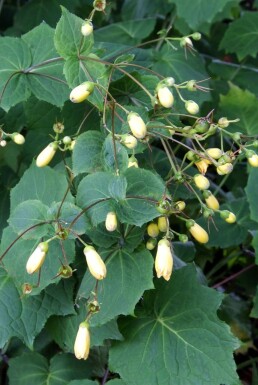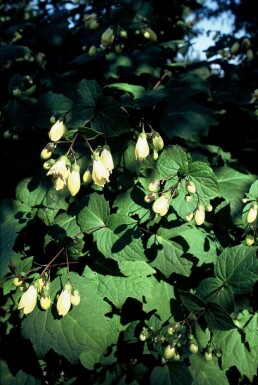

80cm



Updated on 10 September 2025
We regret to inform you that we are currently unable to ship orders to the United Kingdom. We anticipate being able to resume shipments at the beginning of 2026.
Kirengeshoma shines in shaded gardens, offering yellow waxy flowers in late summer. Its palmate leaves and bushy habit enhance borders or woodland edges, making it ideal for moist spaces. Rare and captivating, it's perfect alongside hostas or ferns.


80cm



Kirengeshoma, known for its unique beauty, adds charm to any garden. This shade perennial has maple-like leaves and thick stems, offering structure in late-season gardens. With its yellow waxy bell-shaped flowers that bloom from late summer to autumn, it captivates the eye. Envision these rare yellow wax bells adding a burst of colour in shady borders or woodland areas. Imagine them elegantly paired with hostas or ferns. Discover more about this woodland perennial and understand its allure. Considering to buy Kirengeshoma UK? It could be the perfect choice for those seeking rare shade garden plants.
considering a purchase, Kirengeshoma offers attractive foliage and exceptional blooms for gardens with the right soil preference and moisture conditions. This rare shade garden plant is loved by many for its ability to flower in shaded areas. Yellow wax bells are not only visually appealing but also reliable performers in the right environment. Buy your refined Kirengeshoma (Yellow Wax Bells) from Heijnen and add shaded elegance and autumn bloom to your garden design.Kirengeshoma, also known as yellow wax bells, is a beautiful perennial plant found in shaded gardens. This moisture-loving flower belongs to the Hydrangeaceae family and is known for its striking yellow blooms. Kirengeshoma is often referred to as a late summer shade plant, as it thrives in the cooler, shaded areas of the garden. Other names include Kirengeshoma perennial and moisture-loving flower. Yellow wax bells are primarily used in borders, woodland edges, and natural gardens, adding a touch of elegance with their unique leaf shape and bright flowers. Native to the deciduous forests and mountain slopes of Japan and Korea, they enhance the ecological balance by attracting bees during their blooming period in August and September. In natural habitats, Kirengeshoma plays a role as a late bloomer, providing structural beauty and supporting pollinators. The name Kirengeshoma comes from Japanese, meaning 'yellow flower in the shade,' and is a rare plant often found in spiritual gardens in Japan. This perennial grows moderately, preferring moist, well-drained soil in shaded areas. Ideal for those looking to buy Kirengeshoma in the UK, it's perfect for creating a serene and picturesque shaded garden landscape.
Kirengeshoma, also known as yellow wax bells, is a delightful perennial that thrives in shaded areas. This plant's growth pattern is moderate and it prefers moist, well-drained soil conditions. Its elegant form makes it a striking addition to shaded borders and woodland edges. The plant features thick stems and maple-like leaves that provide structure during the summer months. The development of Kirengeshoma starts in early spring when new shoots emerge. By late summer, it reaches its full height, which can range from 60 cm to 150 cm depending on the type and growing conditions. The beautiful yellow flowers appear in August and September, with factors like temperature, soil preference, and moisture needs influencing blooming. The blooms of Kirengeshoma, characterised by their soft to butter yellow hue, offer a gentle contrast against the green foliage. These waxy bell-shaped flowers hang gracefully on drooping stems. The colour can vary slightly with changes in soil type, light exposure, and plant care. In terms of fragrance, Kirengeshoma (yellow wax bells) is not known for a strong scent. However, its presence contributes to garden biodiversity, attracting pollinators that benefit from the plant's structure and blooms. The mature height varies greatly, influenced by factors such as the specific variety, chosen location, and maintenance practices. This shade-loving perennial is ideal for creating a natural garden feel with its distinctive form and late summer splendour.
Kirengeshoma is known for its large, palmate leaves that have a lobed texture. These leaves display a fresh green colour throughout the growing season, turning to a vibrant yellow in autumn. The leaf structure not only adds visual interest but also helps in shielding the soil beneath from drying out, making it a great choice for shaded and moist garden spots. Kirengeshoma's winter hardiness is quite impressive, capable of withstanding temperatures as low as -29°C. This makes it suitable for USDA zones 5 to 6, where it can thrive even in cold conditions. It is a shade-loving yellow perennial, often blooming in August and September with its distinctive yellow waxy flowers. Though Kirengeshoma is not evergreen, it loses its leaves annually, a typical trait for many perennials. The plant's ability to endure heat and drought is moderate, relying on its shade tolerance and preference for moist conditions. However, its large leaves help conserve soil moisture. Kirengeshoma is not toxic, ensuring safety for gardens with children and pets. Its ecological value is significant, enhancing garden biodiversity with flowers that attract pollinators and provide late summer interest. Growing Kirengeshoma palmata UK gardens can contribute to a more resilient and diverse garden ecosystem, providing valuable food and shelter for wildlife.
Kirengeshoma, a delightful perennial, thrives in the cool and shaded areas of the garden. This plant, with its unique waxy yellow blooms, is an excellent choice for those looking to enhance their outdoor space. Here are some specific ways to use Kirengeshoma in the garden:
Kirengeshoma is perfect for shady borders and woodland gardens. It pairs well with a variety of plant types to create a lush and visually appealing garden. Consider combining Kirengeshoma with hostas for their large leaves that complement its structure. Asplenium, with its delicate fronds, adds a contrasting texture. Actaea provides height and drama with its tall white blooms, while Astilbe's feathery flowers bring a soft touch to the display. Hydrangea macrophylla can also be a striking companion with its bold flowers. These combinations work well because Kirengeshoma offers summer blooms and adds structure with its large leaves. Hostas enhance this by sharing the love for moist and shady spots. Asplenium and Astilbe contribute interesting foliage and delicate blooms, enhancing the overall appearance. Actaea's height ensures a dynamic look, and Hydrangea macrophylla offers a vibrant pop of colour. Kirengeshoma feels at home in shady corners among other garden plants. Each plant supports the others, ensuring a vibrant and harmonious garden throughout the season.
Kirengeshoma thrives in semi-shady to shady locations. This woodland perennial needs 4 to 6 hours of indirect sunlight daily, favouring spots with well-drained, humus-rich soil. Protecting from strong winds is important. Consider planting alongside wind-tolerant varieties or using windbreaks like fencing or hedges. The best soil for Kirengeshoma is acidic and humus-rich. A well-drained soil ensures healthy growth, while regular fertilisation supports development. The large leaves help keep the ground moist, which is essential for this moisture-loving flower. Maintaining proper soil moisture is crucial, especially in windy or sunny conditions that can dry out the soil. Ensure consistent watering, keeping the ground slightly moist without waterlogging. Kirengeshoma prefers a slightly acidic pH level. The pH affects nutrient availability and plant health. Regular testing can help maintain optimal conditions for these late summer shade plants. This plant, also known as yellow wax bells, is a rare gem for shade gardens, known for its unique beauty and resilience. For those looking to buy Kirengeshoma in the UK, creating the right environment will ensure successful growth.
Kirengeshoma should be planted in spring or autumn when the soil is cool and moist. Plants delivered in pots can be planted all year round, except during frost. However, those with a soil ball or roots are best planted in spring and autumn. The distance between Kirengeshoma plants depends on several factors, including the type, size at planting, and growth rate. Typically, the information on planting distance per metre is available on the Heijnen product page.
Proper soil preparation is crucial for Kirengeshoma. The plant thrives in acidic, humus-rich woodland soil, which should be enriched with compost or leaf mould. Using Heijnen planting soil is recommended for the best results. Regular mulching is important, and dry soils should be avoided.
When planting Kirengeshoma, ensure it is placed in a semi-shady to shady spot with well-drained and moist soil. After planting, regular watering and fertilising are necessary to aid growth. This moisture-loving flower has large leaves that help keep the soil from drying, making it a great summer structure plant. Yellow wax bells provide beautiful blooms and are perfect for adding structure to woodland gardens.
Kirengeshoma, also known as yellow wax bells, is a unique plant that thrives in shaded areas. Its beautiful blooms appear from August to September, making it a popular choice for shaded gardens and woodland edges. For its well-being, it requires specific care throughout the year.
Kirengeshoma is a perennial plant that offers a unique charm to any garden. Its flowers appear in late summer and are known for their soft yellow, almost waxy appearance. These blooms stand out particularly well in shaded garden areas. The plant's foliage is equally captivating, with large, fresh green leaves that turn yellow in autumn, adding to its autumnal appeal. Kirengeshoma has soft flowers and belongs to the ornamental grasses. As a woodland perennial, it thrives in moist, shady environments, making it an ideal choice for borders or woodland gardens. The plant's bushy habit provides a lovely structure, ensuring it remains a focal point throughout the year. Another advantage of Kirengeshoma is its ecological contribution. It attracts insects, providing a habitat and food source, thus supporting the garden's biodiversity. These plants are not just visually striking but play a role in promoting a healthy garden ecosystem. The yellow wax bells are rare in cultivation, making them a sought-after addition for gardeners looking to add a touch of the unusual to their garden. In summary, the Kirengeshoma perennial is both beautiful and environmentally beneficial.
Kirengeshoma, also known as yellow wax bells, is a lovely addition to any garden, especially for those looking to enhance their woodland perennial collection. Known for its late flowering, it typically blooms from August to September. Kirengeshoma thrives in shady gardens and is appreciated for its unique leaf shape, making it a standout among shade-loving yellow perennials. Its soil preference is slightly acidic, with moisture needs that cater to well-drained but consistently moist conditions. Below are some popular varieties that are ideal for those wanting to grow Kirengeshoma palmata in the UK.
These popular Kirengeshoma varieties can be ordered online from Heijnen, ensuring that any garden can benefit from their unique beauty and late blooming qualities.
Kirengeshoma, also known as yellow wax bells, is a unique plant that adds charm to shaded areas in gardens. This plant is a great choice for enhancing the beauty of a garden with its unique characteristics.
Advantages:
Disadvantages:
Proper soil preparation, correct placement, and adequate care and timely fertilisation reduce the risk of diseases and pests. Providing the right care ensures optimal growth and flowering for Kirengeshoma (yellow wax bells).
Kirengeshoma is a perfect addition for those seeking unique plants for shady borders or woodland gardens. Known for its intriguing leaf shape and vibrant blooms in August and September, this plant thrives in moist conditions, making it ideal for a garden with hostas or ferns. Its rare cultivation adds a special touch to any garden design, ensuring that it stands out. The yellow wax bells are particularly striking, providing a beautiful display in areas where other flowers may struggle. When
We would like to provide some tips on how to plant and care for a Kirengeshoma. By following these tips, you can be sure to enjoy your Kirengeshoma for a long time.
Kirengeshoma thrives best in semi-shady to shady areas with humus-rich, well-drained soil. The plant prefers conditions that offer 4 to 6 hours of indirect sunlight, making it ideal for woodland edges or shaded gardens. Proper placement encourages robust growth, vibrant blooms, and healthier foliage. The choice of acidic, moist soil is crucial, as it aids in nutrient absorption, leading to richer colouring and stronger resistance to environmental stress. Kirengeshoma is well-suited to shady borders and moist gardens, often paired with hostas or ferns for an attractive display. Although tolerant of cold and moisture, ensuring the soil remains consistently moist without waterlogging enhances its growth. Planting in spring or autumn is optimal for this perennial. Positioning is key, as the right spot ensures blooming success and a captivating garden presence.
Preparing the soil is key when planting Kirengeshoma, also known as yellow wax bells. Good ground preparation helps ensure the plant gets enough water and nutrients. Start by enriching the soil with compost, mixing it well into the existing soil to improve drainage and nutrient content. Before planting, make sure the ground is pliable and fertile. Proper soil preparation allows the plant to establish strong roots before it starts growing. It is important to plant these perennials during spring or autumn in cool and moist conditions. For potted Kirengeshoma, they can be planted year-round, except during frost. After planting, water the plants well until they are rooted in the soil. The size of the plant will determine how many can be planted per square metre. Remember, healthy soil leads to healthy plants.
Fertilising Kirengeshoma is crucial for ensuring vibrant growth and flowering. Regular feeding boosts the plant's health and vitality, leading to more abundant blooms of yellow wax bells. For optimal results, employ Heijnen's organic or organic-mineral fertiliser. It's designed to enhance growth, promote rich flowering, and maintain plant vitality. Apply fertiliser twice yearly: first in spring with compost or leaf feed, and a second dose in July if the soil is poor. The amount used depends on the plant's size, ensuring nutrients are tailored to specific needs. Nutrient absorption occurs once the fertiliser mixes with water in the soil. During dry spells, it's important to water the garden after fertilising to help nutrients reach the roots of Kirengeshoma. This process maintains the plant's lush appearance and supports the development of its beautiful, butter-yellow blooms.
Kirengeshoma requires minimal pruning. It is important to prune dead branches and remove faded flowers in early spring. This helps maintain the plant’s health and appearance. When pruning, sharp secateurs are essential to make clean cuts and prevent damage. Good tools ensure precise work, which supports the plant's growth. By removing dead stems, the plant can focus its energy on new growth, resulting in a healthier appearance. Kirengeshoma does not need hard pruning, which makes it an easy plant to care for. Its preference for humus-rich, moisture-retentive soil should be noted, as it contributes to the plant's thriving growth. Regular light pruning encourages a neat look and allows the plant to flourish as a stunning late summer shade addition. By following these steps, Kirengeshoma will enhance any garden with its beauty.
Kirengeshoma needs plenty of water, but it is important to avoid waterlogging. Newly planted Kirengeshoma should be watered well to help them establish roots. Once settled, watering is only necessary during long dry spells. Giving a good soak is better than small amounts daily. It's best to water early in the morning or late in the afternoon to reduce evaporation. Checking the soil is essential to determine if watering is needed. The soil should feel moist but not soggy. Excess water should always be able to drain away, whether Kirengeshoma is planted in the ground or in pots. Drip irrigation systems are helpful once the plant is established but should be supplemented with regular watering during the establishment phase. Kirengeshoma is not drought-tolerant, so keeping the soil evenly moist is key for healthy growth of these yellow wax bells.
Kirengeshoma, a unique addition to any garden, thrives in shady areas. It displays stunning yellow wax bells that bloom in late summer, adding vibrant colour to the garden. Originally from Japan, the name means 'yellow flower in the shade'. This perennial is ideal for woodland settings, offering attractive foliage and beautiful blooms. With its non-toxic nature, it is safe for gardens with children and pets. Admired for its rarity, Kirengeshoma is a delightful choice for those seeking something different.
Kirengeshoma, known for its elegant foliage and yellow wax bells, thrives with regular division. This process rejuvenates the plant, removing old parts and encouraging healthy growth. Dividing also helps maintain optimal plant health and can prevent overcrowding. To divide Kirengeshoma, carefully dig up the plant. Remove any aged sections and separate the younger parts. Replant these in well-prepared soil, ensuring they have enough space to grow. It's best to divide every three to four years, ideally in early autumn. This timing allows the plant to establish before the colder months. A sharp spade or knife works well for this task, ensuring clean cuts that minimise damage. Regular division keeps Kirengeshoma vibrant and productive, enhancing any garden with its unique charm.
Yellow wax bells are a unique woodland perennial with maple-like leaves and thick stems. They bloom with soft yellow, waxy bell-shaped flowers from late summer to autumn, thriving in shady spots. Their attractive foliage and structure make them perfect for shady borders and woodland gardens. These plants are also rare in cultivation and can attract bees. Buy your refined Kirengeshoma (Yellow Wax Bells) from Heijnen to enhance your garden's allure.
